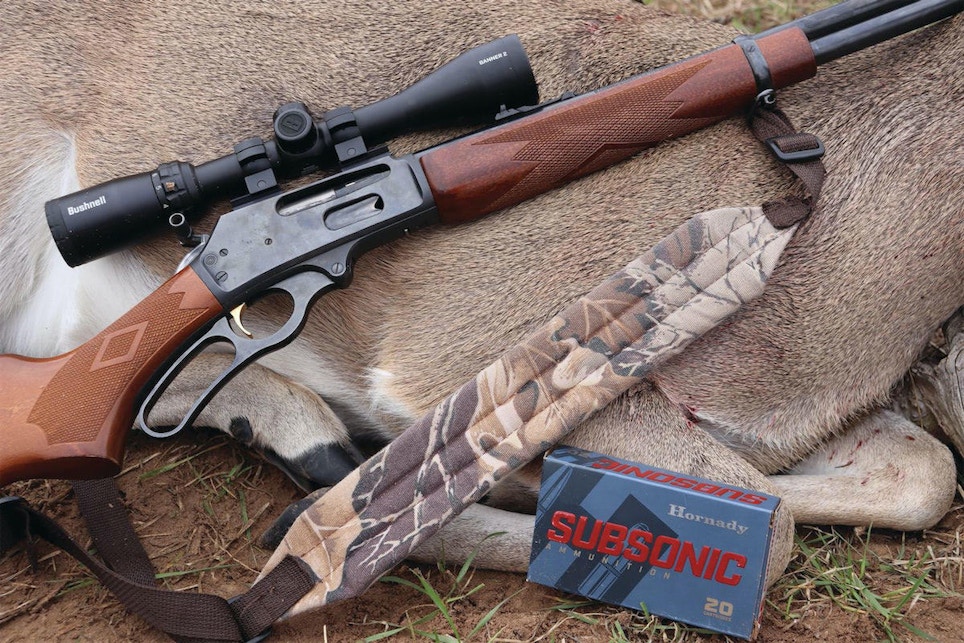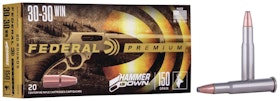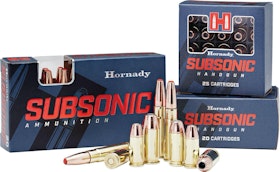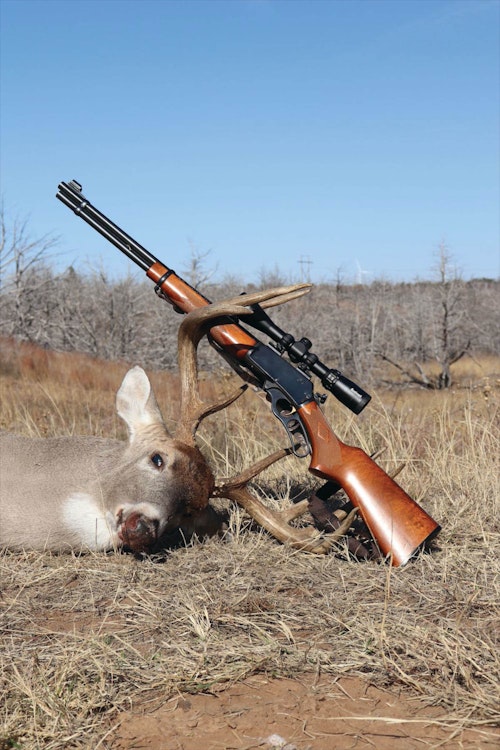After 25 agonizing minutes, the big buck finally left his feeding spot only 75 yards in front of me on a green northwest Oklahoma wheat field and vanished into the thick blackjack woods along the north edge.
I say “agonizing” because I had filled my rifle tag on a somewhat smaller buck the day before, but rules are rules and sometimes you have to let the big boy walk. Fortunately, I still had ammunition to test, and two doe tags in my pocket.
I didn’t have long to wait as two mature does soon trotted out onto the field and began feeding. Resting the crosshairs of my rifle just behind the larger doe’s shoulder, I clicked off the safety and slowly took up the slack on the trigger.
At the report, one doe hightailed it for the woods, leaving a trail of dust in the air behind her. The other lay still on the ground, flat on her side as though struck by lightning — not always the normal reaction of deer shot with a .30-30.
The .30-30 Today
The .30-30, of course, is far from a new chambering. Released in 1895, just a year after the popular Model 1894 Winchester lever gun was introduced, the .30-30 Win. was the first sporting cartridge loaded exclusively with smokeless powder.
The original .30-30 Winchester load had a 160-grain round-nosed bullet leaving the muzzle at 1,970 feet per second, a substantial step up from other popular cartridges of the time like the .32-40 Win. (165-grain bullet at 1,450 fps) and .38-55 Win. (255-grain bullet at 1,320 fps). The cartridge’s speed and power, combined with the lever-action’s capacity and quickness, made it an instant hit as a deer cartridge. In little time it was the choice of many who were serious about putting venison on the dinner table.
Over the past 125 years, many more powerful, flatter-shooting cartridges have been introduced, winning over the hearts and minds of many American deer hunters. While some stalwart .30-30 lovers still took their beloved lever gun to the fields, many pushed them to the back of the gun safe.
Then, in 2005 Hornady introduced its LEVERevolution ammo, which used an elastomer flex tip on a spitzer bullet, making it safe for use in the gun’s tubular magazine but ballistically superior to its round-nosed predecessors. Hornady’s introduction of the Evolution ammo was just the shot in the arm the .30-30 needed. The new Evolution bullets delivered a substantially higher ballistic coefficient than the previous round-nosed ammunition required for the tube-fed rifles. They also retained more downrange energy.
Suddenly, .30-30s began showing back up in the hands of hunters who had shelved them. After all, Hornady had basically turned a 100-yard deer rifle into a 200-yard tool overnight.
While the Evolution ammo continues to be popular, it’s not the new kid on the block. Just in the past few years both Hornady and Federal introduced new ammo specifically designed for deer hunters using the .30-30. And it was one of those loads that so authoritatively flattened the doe mentioned earlier.
The Ammo
The two .30-30 loads introduced last year were Federal’s new HammerDown load, and Hornady’s Sub-X Subsonic round. Since I was using the Federal offering in the aforementioned hunt, let’s take a look at it first.
I first learned about HammerDown from a press release boasting of nickel-plated brass with a Gold Medal primer seated in place and a specially formulated propellant that the company said provided superior ballistics through lever-action rifles. The kicker was a molecularly bonded bullet that the company said was designed to deliver best-in-class expansion and weight retention. As a longtime lever gun fan, I was intrigued.
On the range with an old rifle I’ll discuss later, I found the new ammo to be quite accurate. While it didn’t match the precision of high-quality competition fodder fed through a $10,000 bolt gun, performance was plenty good for most deer hunting purposes.
Unfortunately, I was carrying a different rifle chambered in a different caliber the day before when I shot my buck. But shooting the doe with the HammerDown ammo left little doubt in my mind that it’ll get the job done on white-tailed deer at legitimate lever-gun distances. I wasn’t able to recover the bullet as it passed all the way through the animal, but it definitely put the hammer down on that deer and put some extra meat in the freezer.
The other new offering, Hornady’s subsonic Sub-X, is a unique one indeed. As suppressors become more popular and more and more companies offer lever rifles threaded for a muzzle device, this ammo will also put the hurt to whitetails at typical lever action range, although I wasn’t able to get any in time for my hunt last fall.
The Sub-X round uses the popular XTP bullets designed specifically to expand reliably at subsonic speeds — a necessity for hunting deer and other similar-size game. Featuring a lead core, the projectile has long grooves in its gilded metal jacket and a Flex Tip insert inside its hollow-point cavity. Plus, the company says it features powders selected for optimal performance and consistency from lot to lot.
Of course, Hornady’s Evolution ammunition is still stellar fodder for .30-30 lever guns anywhere deer live. It’s not the gun and load you’d use on a deer at 300 yards across a high mountain valley, but out to a couple hundred yards it will still do the job quite nicely.
And never forget those old-fashioned solid lead flat- or round-nose bullets shot from a .30-30. They’ve probably killed as many deer over the years as any other caliber. They’re available in weights from 150 to 170 grains from nearly all major manufacturers. Some to check out include Federal’s 170-grain Power-Shok and 150-grain Fusion, Remington’s 150- and 170-grain Core-Lokt, Winchester’s Super-X 150-grain Power-Point, and Sellier & Bellot’s 150-grain SP load.
The Rifles
The .30-30 lever action I was using for the hunt mentioned earlier was Marlin’s venerable Model 336, a rifle that has been in production since 1948. I bought the rifle for my oldest son as his first deer rifle when he turned 11, nearly 20 years ago, and it had sat in the safe for the last eight or 10 years as we hunted with other, more modern calibers that have gained popularity.
Hearing of two new offerings, I decided to pull the old 336 out of the safe and see what it might do. Still wearing an ancient, low-end scope from two decades ago, I decided new glass was in order. Since I wasn’t going to be taking any long-range shots with a .30-30, my choice was the Bushnell Banner 2 in 3-9x. At under $100, this scope offers good quality optics at a very reasonable price point.
While I wasn’t able to get my hands on the new Hornady round, the Federal HammerDown load gave me plenty to like. Decked with the Bushnell, I was able to shoot 100-yard, five-shot groups in the 2.5-inch range. That’s not tack driving by today’s standards, but for an old .30-30 it’s pretty darned good performance. And for whitetails out to 100 yards, I didn’t need to be able to hit a nickel at 500 yards.
While you might think stocking new 336s in your shop is something you won’t be able to do anymore because of recent changes in the industry, your fears are actually unfounded. After changing hands numerous times over the years, Marlin was part of Remington when that company declared bankruptcy last year. Fortunately for lever gun fans, Ruger purchased Marlin in late 2020 and is expected to continue producing the Model 336. With the high quality of Ruger’s firearms across the board, that’s exciting news.
Several other companies make some very fine .30-30 lever guns, and since lever aficionados often have their favorites, it’s wise to carry a good selection in your firearm inventory.
Mossberg is right at the top of the heap, with a number of lever guns available chambered in .30-30. That company’s Model 464 is a good one that can be found in a few different barrel lengths and a number of finishes, including classic blued with walnut stock. For the tactical shopper, the gun is also available in a black synthetic stock with a matte blued finish. And for those who hunt in inclement climates, the 464 is even available in a Mainecoat finish with a gray laminate stock.
For gun shoppers looking for a higher-end .30-30, Henry Firearms has some nice offerings that are as beautiful as they are accurate. Henry’s newest lever gun is its Slide Gate Lever Action rifle available in .30-30 and a handful of other calibers. The gun offers Henry’s typical high quality along with side-gate loading, a first for Henry. The company also offers a number of other models chambered in .30-30.
A Little Boost
In the end, the venerable .30-30 has been around for over 125 years and isn’t going anywhere soon. As ammo companies have breathed new life into it, gun companies have followed suit by expanding the models they offer or offering updated versions of existing lever-action .30-30s.
In this era of high-powered, high-dollar bolt guns with never-before-seen accuracy, the old-fashioned lever gun still deserves some attention. And since many old-timers have the expendable income to add a new gun or two to their safes, offering a few lever-action rifles could boost your bottom line.









